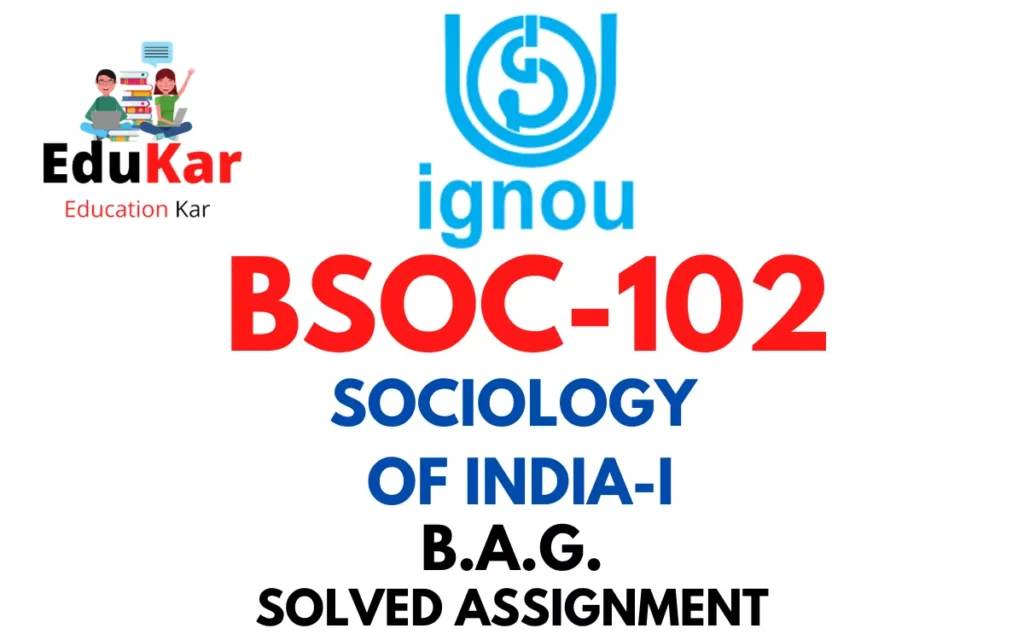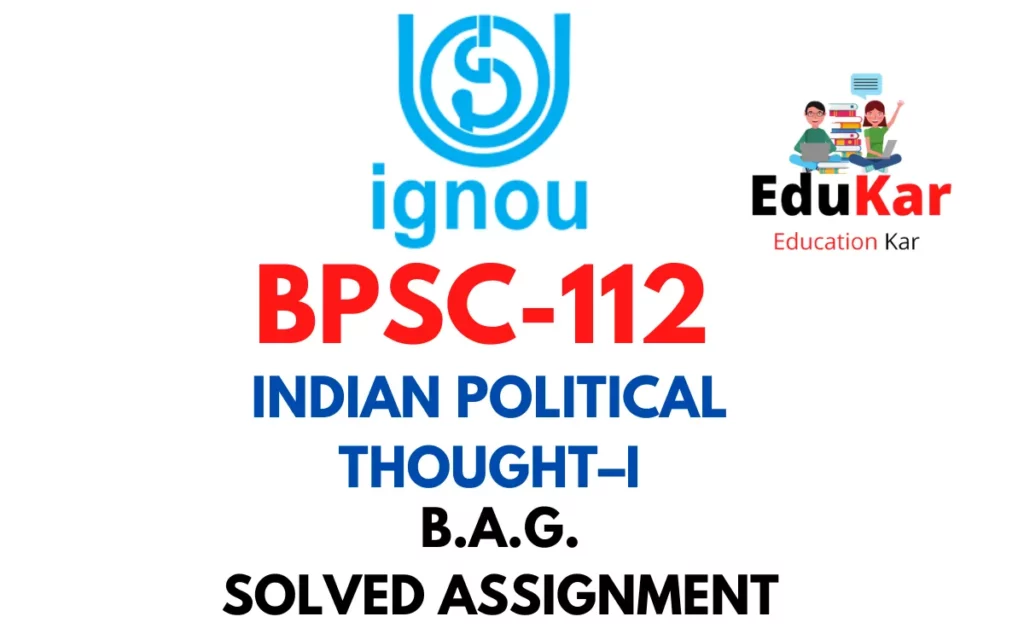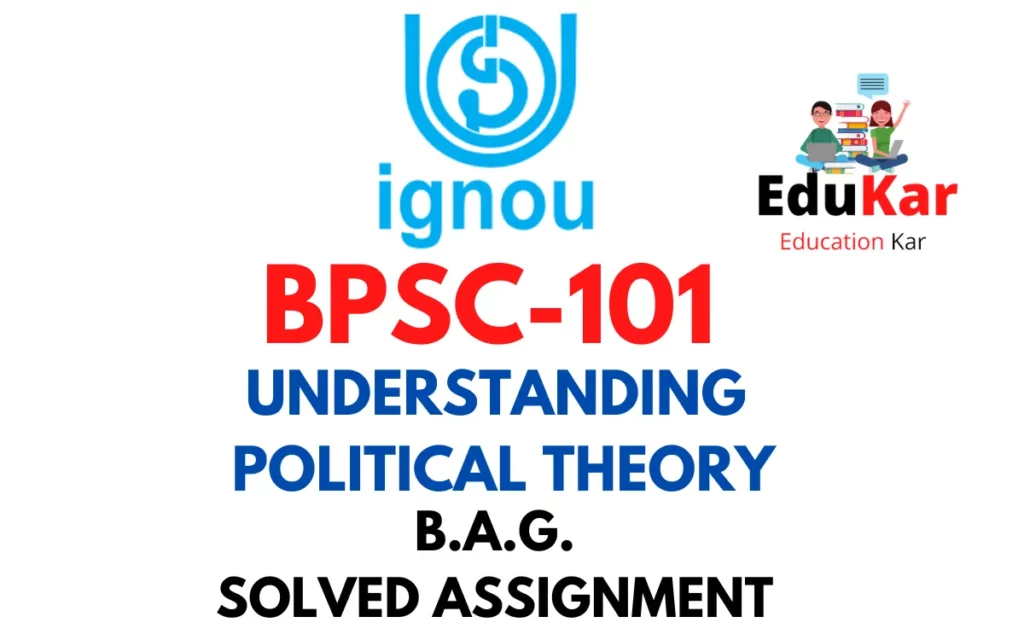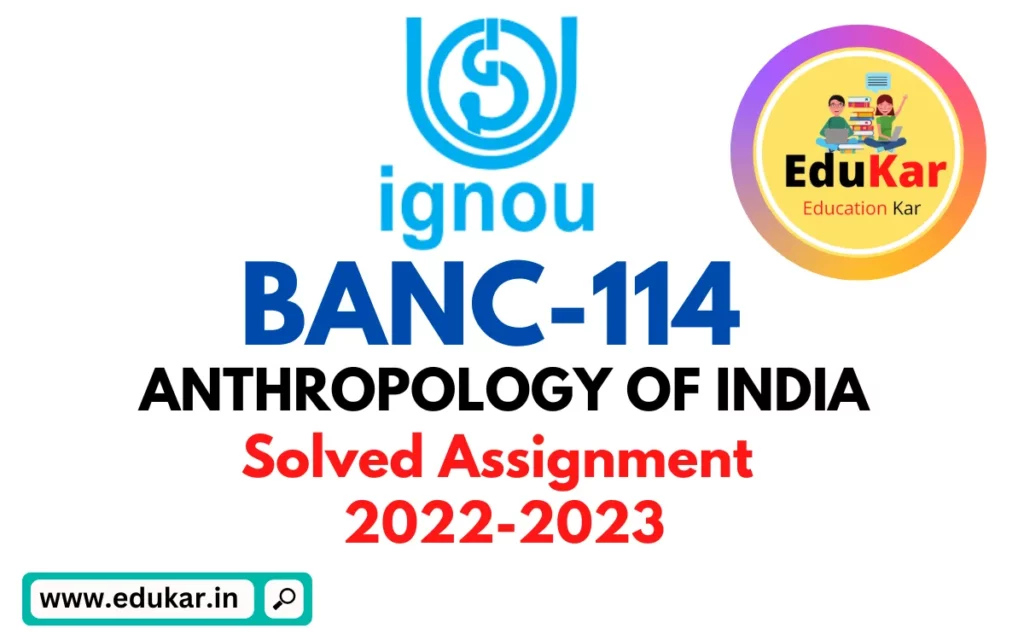Contents
- 1 Assignment – I
- 2 Answer the following in about 500 words each.
- 3 1. Describe the tradition of plurality and the culture of accommodation in Indian society.
- 4 2. What do you understand by social change and modernization in India? Discuss
- 5 Assignment – II
- 6 Answer the following questions in about 250 words each.
- 7 3. Discuss the meaning of ethnographic image of India with a suitable example.
- 8 4. Describe the basic features of village in India.
- 9 5. There are many tribes in India found in different regions. Discuss the nature of their occupations.
- 10 Assignment – III
- 11 Answer the following questions in about 100 words each.
- 12 6. Define the concept of Caste.
- 13 7. Why is India considered to be a ‘unity in diversity’?
- 14 8.What is ‘Great Tradition’ and ‘Little Tradition’?
- 15 9. What are the basic tenets of Indian Constitution?
- 16 10. What are the major religions in India?

| Title | BSOC-104: IGNOU BAG Solved Assignment 2022-2023 |
| University | IGNOU |
| Degree | Bachelor Degree Programme |
| Course Code | BSOC-104 |
| Course Name | SOCIOLOGY OF INDIA-II |
| Programme Name | Bachelor of Arts (General) |
| Programme Code | BAG |
| Total Marks | 100 |
| Year | 2022-2023 |
| Language | English |
| Assignment Code | BSOC-104/ASST/TMA/2022-23 |
| Assignment PDF | Click Here |
| Last Date for Submission of Assignment: | For June Examination: 31st April For December Examination: 30th September |
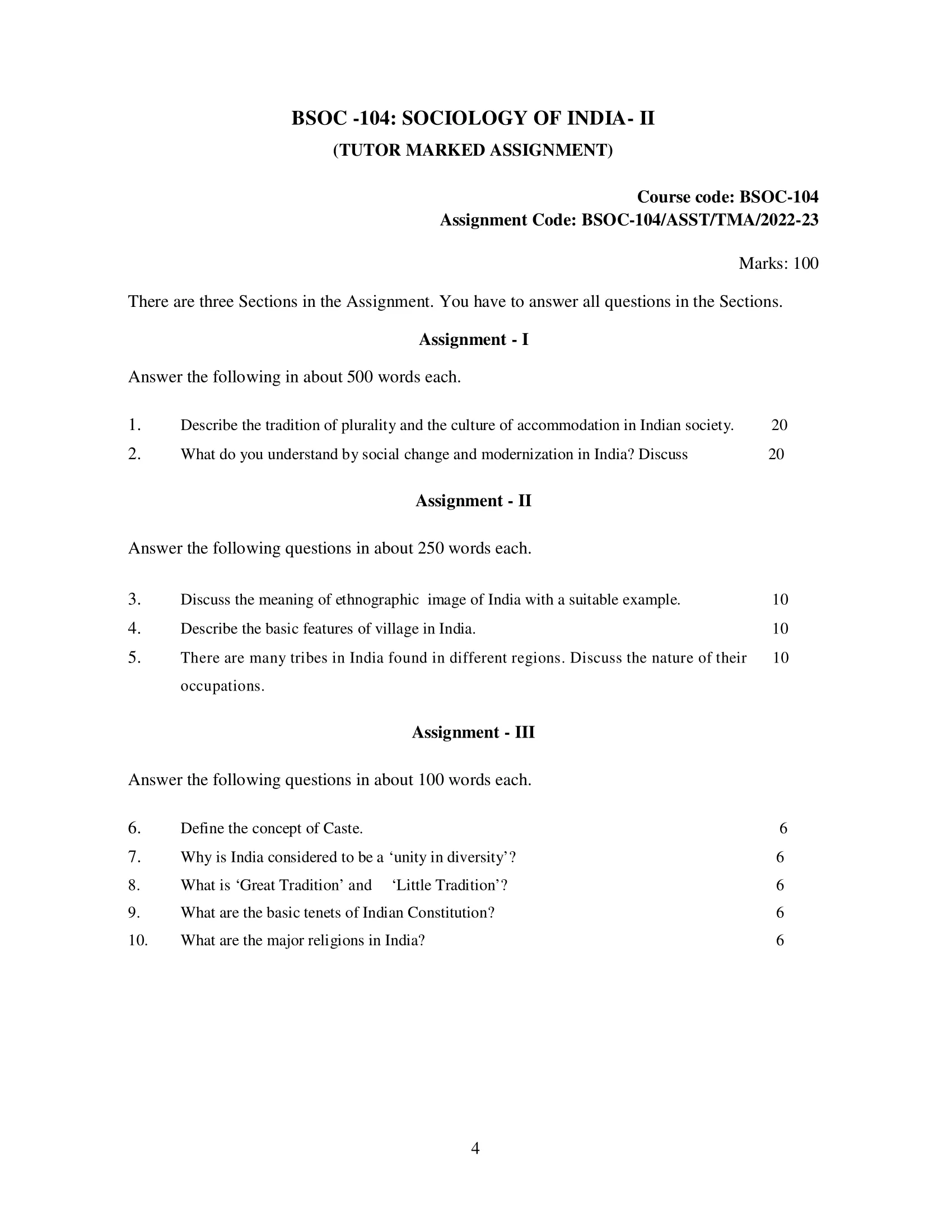
Assignment – I
Answer the following in about 500 words each.
1. Describe the tradition of plurality and the culture of accommodation in Indian society.
Ans: India has a long tradition of plurality and a culture of accommodation that has been a defining characteristic of its society for centuries. This tradition has been shaped by the diversity of the Indian subcontinent, which is home to numerous ethnic, linguistic, and religious groups. Despite this diversity, India has managed to maintain a sense of unity and coexistence between its different communities. This culture of accommodation has been instrumental in creating a harmonious and inclusive society that respects and celebrates differences.
The tradition of plurality in India can be traced back to ancient times when different religious and philosophical traditions coexisted and interacted with each other. The Indus Valley Civilization, which flourished around 2600 BCE, was characterized by a cosmopolitan culture that included a diverse range of religious and cultural practices. The Vedic period, which followed the Indus Valley Civilization, was marked by the emergence of Hinduism as a dominant religion, but it also saw the growth of Buddhism and Jainism, which offered alternative paths to salvation. These religions not only coexisted but also influenced each other, leading to the development of a syncretic culture.
The Mughal Empire, which ruled India from the 16th to the 18th century, was another significant period in the country’s history. The Mughals were Muslims who had come from Central Asia and Persia, and they brought with them a rich cultural heritage that blended with the local traditions. The Mughal era saw the development of a unique style of architecture and art that combined Persian, Central Asian, and Indian elements. The Mughals also had a policy of religious tolerance and encouraged the coexistence of Hindus and Muslims.
In modern times, India’s tradition of plurality and culture of accommodation has been reflected in the country’s Constitution, which recognizes and protects the rights of all citizens, regardless of their religion, caste, or language. India is home to numerous religious groups, including Hindus, Muslims, Christians, Sikhs, Buddhists, Jains, and Zoroastrians, among others. Each of these groups has its own customs, traditions, and beliefs, but they coexist peacefully and celebrate each other’s festivals.
The culture of accommodation in India is based on the principle of respecting and valuing differences. This principle is reflected in many aspects of Indian society, including its food, clothing, music, and dance. For example, Indian cuisine is diverse and includes a range of vegetarian and non-vegetarian dishes that reflect the culinary traditions of different regions. Similarly, Indian clothing is varied and includes traditional garments such as sarees, salwar kameez, and dhotis, as well as modern clothing styles.
The culture of accommodation is also reflected in Indian music and dance, which are characterized by a blend of different styles and influences. For example, classical Indian music has been influenced by Persian, Central Asian, and Western music, while Bollywood music is a fusion of Indian and Western styles. Similarly, Indian dance forms such as Bharatanatyam, Kathak, and Odissi have been influenced by different regional and folk dance forms.
Ans: Social change and modernization are two interrelated phenomena that have had a profound impact on Indian society in the 20th and 21st centuries. Social change refers to the process by which a society transforms its social, economic, and cultural structures over time. Modernization, on the other hand, refers to the adoption of modern technologies, institutions, and values by a society, which can lead to significant changes in its social, economic, and political systems.
In India, social change and modernization have been occurring simultaneously, and both have been driven by a range of factors, including globalization, urbanization, and the spread of education. Some of the major social changes and modernization processes that have taken place in India are discussed below:
- Economic changes: India’s economy has undergone significant transformation over the past few decades, moving from an agricultural-based economy to a more diversified one. The growth of the service sector, the expansion of the middle class, and the rise of entrepreneurship and start-ups are all signs of economic modernization in India.
- Technological changes: India has made remarkable progress in the field of information technology, which has transformed the way people work, communicate, and access information. The growth of e-commerce, mobile banking, and online education is a testament to India’s technological modernization.
- Urbanization: India is experiencing rapid urbanization, with more and more people migrating to cities in search of better opportunities. This has led to the growth of urban areas, the emergence of new social and cultural norms, and changes in the family structure and relationships.
- Women’s empowerment: India has made significant progress in empowering women and promoting gender equality. Women are increasingly participating in the workforce, pursuing education, and taking on leadership roles. This has brought about changes in traditional gender roles and relationships.
- Political changes: India has a vibrant democracy that has been strengthened by the expansion of political rights, the growth of civil society, and the emergence of new political movements. These changes have led to a more participatory and accountable political system.
However, these changes have also brought about new challenges, such as income inequality, environmental degradation, social fragmentation, and cultural homogenization. Additionally, the pace and direction of social change and modernization in India have been shaped by various social, economic, and political factors, including regional disparities, caste and class divisions, linguistic and cultural differences, and political instability.
Assignment – II
Answer the following questions in about 250 words each.
3. Discuss the meaning of ethnographic image of India with a suitable example.
Ans: The ethnographic image of India refers to the way in which India is perceived by outsiders, particularly Westerners, through a lens of exoticism and cultural difference. This image has been constructed over centuries through a variety of media, including literature, art, film, and travelogues. The ethnographic image of India has been shaped by a range of factors, including colonialism, Orientalism, and global tourism. While the image of India as an exotic and mystical land has its roots in historical reality, it has also been perpetuated and exaggerated through popular media.
A suitable example of the ethnographic image of India can be found in the Western perception of yoga. Yoga has become a hugely popular practice in the West, with millions of people practicing it regularly as a form of exercise and stress relief. However, the way in which yoga is often portrayed in the West can be seen as an example of the ethnographic image of India. Yoga is often presented as a mystical and exotic practice, associated with the ancient wisdom of the East. It is often depicted in media as being practiced by sages in remote locations, or as part of colorful and exotic cultural festivals.
While yoga is indeed an ancient practice with roots in India, the way in which it is portrayed in the West can be seen as an example of the exoticization of Indian culture. This image of yoga as a mystical and exotic practice obscures the fact that it is a complex and nuanced system of physical and spiritual practice that is deeply integrated into Indian culture. It also tends to reinforce stereotypes about India as a land of mystics and sages, rather than a complex and diverse society with a rich and varied cultural heritage. Overall, the ethnographic image of India is a complex and multifaceted phenomenon that has evolved over centuries, and which continues to shape the way in which India is perceived by outsiders today.
4. Describe the basic features of village in India.
Ans: India is a country with a rich history of rural settlements, and the village has been a fundamental unit of rural life in India for centuries. The basic features of a village in India can be broadly categorized into physical, social, and economic aspects.
Physical features: Most Indian villages are characterized by a compact settlement pattern, with houses built closely together in a central cluster. The houses are usually made of mud, brick, or stone, and are typically single-story structures with thatched or tiled roofs. The village is often surrounded by fields, pastures, and forests, which are used for agricultural and other productive purposes.
Social features: The social structure of a typical Indian village is hierarchical, with caste and religion playing a significant role in determining social status. The village community is usually tightly knit and there is a strong sense of community identity. The village panchayat (a form of local self-government) plays an important role in managing village affairs and resolving disputes. The village often has a temple or mosque as a central point of worship and community activity.
Economic features: Agriculture is the primary economic activity in most Indian villages, with farmers growing a variety of crops such as wheat, rice, millet, and pulses. The land is typically owned by a few wealthy individuals, with most of the rest of the population working as laborers or sharecroppers. Small-scale industries such as handicrafts and cottage industries are also common in many villages. The village economy is often closely linked to the local market, with goods being traded through a network of small traders and merchants.
5. There are many tribes in India found in different regions. Discuss the nature of their occupations.
Ans: India is home to a large number of tribes, each with its own distinct culture, language, and way of life. These tribes are found in different regions of the country and have adapted to their local environments over generations. The nature of their occupations varies depending on factors such as geography, climate, and access to resources.
Here are some examples of the nature of the occupations of different tribes in India:
- The Baigas: The Baigas are a tribal community found in the central Indian state of Madhya Pradesh. They are primarily dependent on agriculture, and their main crops include rice, millet, and maize. They also collect non-timber forest products such as medicinal plants, fruits, and honey, and hunt small game for food.
- The Gonds: The Gonds are a tribal community found in central and eastern India. They are primarily agriculturalists, and grow crops such as rice, millet, and pulses. They also engage in cattle rearing and fishing, and collect forest products such as fruits, tubers, and honey.
- The Todas: The Todas are a tribal community found in the southern Indian state of Tamil Nadu. They are primarily pastoralists, and rear a unique breed of buffalo called the Toda buffalo. They also grow crops such as ragi and wheat, and collect forest products such as wild fruits and medicinal plants.
- The Santhals: The Santhals are a tribal community found in the eastern Indian states of Jharkhand, West Bengal, and Odisha. They are primarily agriculturalists, and grow crops such as rice, maize, and vegetables. They also engage in animal husbandry, and collect forest products such as firewood, fruits, and medicinal plants.
- The Bishnois: The Bishnois are a tribal community found in the western Indian state of Rajasthan. They are primarily pastoralists, and rear cattle, sheep, and goats. They also engage in agriculture, and grow crops such as millet and pulses. The Bishnois are known for their commitment to environmental conservation, and have a long history of protecting the local flora and fauna.
Assignment – III
Answer the following questions in about 100 words each.
6. Define the concept of Caste.
Ans: Caste refers to a social system in which individuals are born into specific social groups or castes that are determined by their birth, and which dictate their social status, occupation, and cultural practices. The caste system is primarily associated with India, where it has been in existence for thousands of years, and is based on a hierarchical structure with the Brahmins (priests and scholars) at the top and the Dalits (formerly known as “untouchables”) at the bottom. While the Indian government has made efforts to eliminate the caste system, it continues to be a significant factor in Indian society and has a profound impact on social, economic, and political relationships.
7. Why is India considered to be a ‘unity in diversity’?
Ans: India is often referred to as a “unity in diversity” because of its remarkable diversity in terms of culture, language, religion, ethnicity, and geography, which are united by a shared history and identity. India is home to more than 1.3 billion people, who speak over 19,500 languages and dialects, practice several religions, and follow diverse customs and traditions.
Despite this diversity, India has maintained its unity as a nation, primarily through a shared cultural heritage, democratic values, and a commitment to secularism. India’s ancient history and culture have contributed significantly to its unity, as it has given rise to shared traditions, such as yoga, classical dance, music, and philosophy. The Indian Constitution, which guarantees fundamental rights to all citizens, irrespective of their background, has also been instrumental in promoting national unity and integration.
Moreover, India’s democratic system of governance, with free and fair elections and a vibrant civil society, has provided a platform for diverse groups to express their opinions and participate in the decision-making process. The government has also made efforts to promote national integration by encouraging cultural exchanges, promoting regional languages and literature, and celebrating festivals that are common to all communities.
8.What is ‘Great Tradition’ and ‘Little Tradition’?
Ans: The concepts of Great Tradition and Little Tradition were first introduced by the anthropologist Robert Redfield to describe the relationship between the dominant culture and the local culture in traditional societies.
The Great Tradition refers to the dominant culture of a society, which is usually associated with the elite or the educated classes. This includes formal education, literature, religion, and other high culture practices. The Great Tradition is often transmitted through formal institutions like universities, religious organizations, and state agencies.
In contrast, the Little Tradition refers to the local culture of a society, which is practiced by the common people or the folk. This includes local customs, beliefs, rituals, and practices that are not part of the dominant culture. The Little Tradition is often transmitted informally through families, communities, and social networks.
Redfield argued that the Great Tradition and Little Tradition are often in tension with each other, with the dominant culture trying to assimilate or suppress the local culture. However, in many cases, the local culture adapts and modifies the dominant culture to suit its own needs, creating a dynamic process of cultural exchange and transformation.
The concepts of Great Tradition and Little Tradition have been used to understand the relationship between the high culture and the popular culture in many societies, including India. In India, for example, the Great Tradition is associated with classical music, art, literature, and religion, while the Little Tradition is associated with folk music, dance, rituals, and local customs. The relationship between these two traditions has been a subject of ongoing debate and negotiation in India, with efforts being made to promote both the Great Tradition and the Little Tradition in a way that respects their unique identities and contributions to the cultural heritage of the country.
9. What are the basic tenets of Indian Constitution?
Ans: The Indian Constitution is a comprehensive document that lays down the framework for India’s system of government and sets out the rights and responsibilities of its citizens. The basic tenets of the Indian Constitution can be broadly categorized as follows:
- Sovereign, socialist, secular, democratic, and republican: These are the core values enshrined in the preamble of the Indian Constitution. India is a sovereign country, with a democratic and republican form of government, committed to socialism and secularism.
- Fundamental rights and duties: The Constitution guarantees certain fundamental rights to all citizens, such as the right to equality, freedom of speech and expression, and the right to practice any religion. At the same time, citizens are also expected to fulfill certain duties, such as respecting the Constitution and contributing to the welfare of the community.
- Separation of powers: The Constitution provides for a separation of powers between the legislature, executive, and judiciary, to ensure a system of checks and balances.
- Federalism: India is a federal country, with powers and responsibilities divided between the central government and the state governments.
- Directive principles of state policy: The Constitution lays down certain guidelines for the government to follow in its policies and programs, to promote the welfare of the people and achieve a just and equitable society.
- Independent judiciary: The Constitution provides for an independent judiciary, with the power of judicial review, to ensure that the rights of citizens are protected and the laws are upheld.
10. What are the major religions in India?
Ans: India is a land of diverse religious beliefs and practices, and has been the birthplace of several major world religions. The major religions in India include Hinduism, Islam, Christianity, Buddhism, Jainism, Sikhism, and Zoroastrianism.
Hinduism is the dominant religion in India, with over 80% of the population identifying as Hindus. Islam is the second-largest religion in the country, with around 15% of the population being Muslims. Christianity, Buddhism, Jainism, and Sikhism are also practiced by significant minorities in India. Zoroastrianism, although not a major religion, is still practiced by a small but significant population of Parsis in India.
Each of these religions has its own unique history, beliefs, and practices, and has made a significant contribution to India’s rich cultural heritage. The diversity of religions in India has also led to a long tradition of religious tolerance and coexistence, making it a unique example of multiculturalism in the world.
How to Download BSOC-104 Solved Assignment?
You can download it from the www.edukar.in, they have a big database for all the IGNOU solved assignments.
Is the BSOC-104 Solved Assignment Free?
Yes this is absolutely free to download the solved assignment from www.edukar.in
What is the last submission date for BSOC-104 Solved Assignment?
For June Examination: 31st April, For December Examination: 30th October





